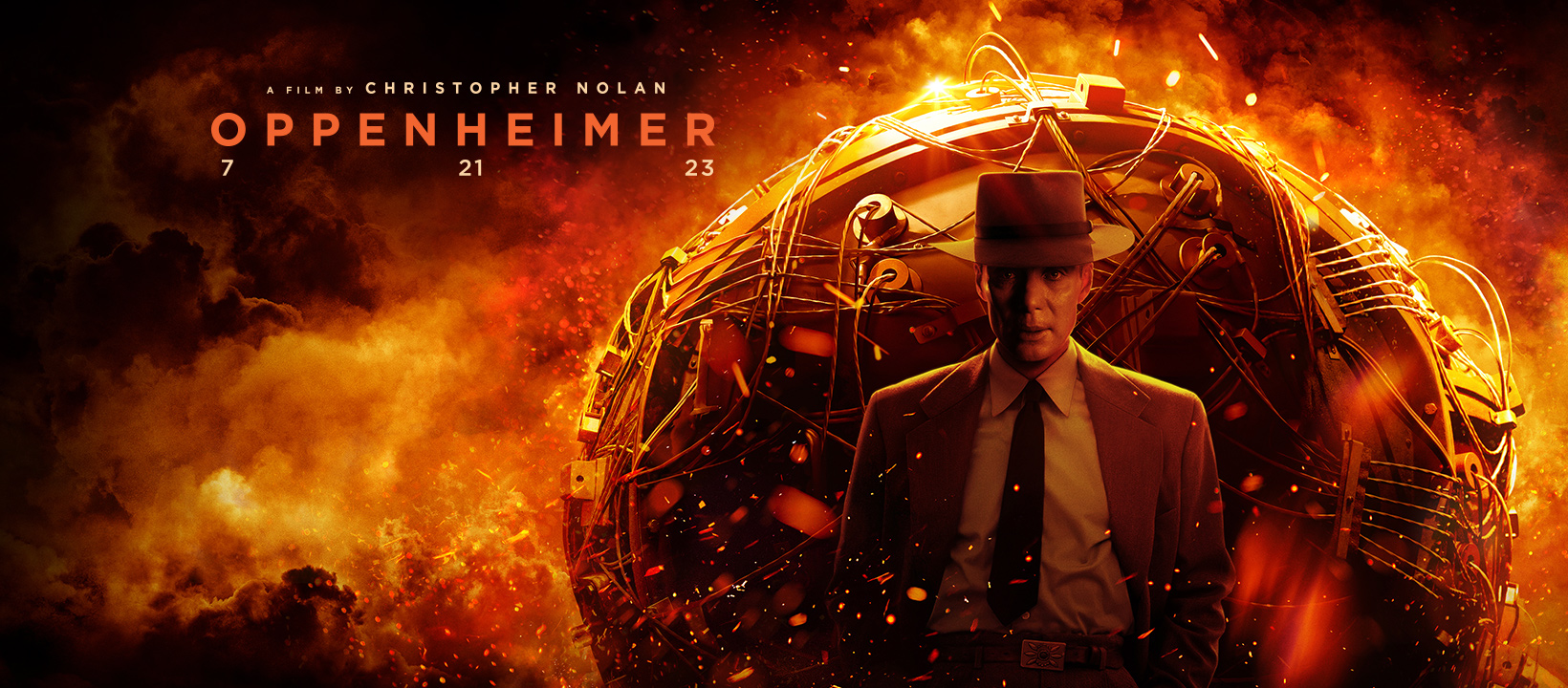
Print and Featurers Editor Jess Parker reviews Oppenheimer, finding it a rich and enthralling watch despite some pacing and mixing issues.
Director and writer Christopher Nolan’s IMAX-shot biographical epic Oppenheimer (2023) follows the story of J. Robert Oppenheimer: a theoretical physicist who was tasked with directing the Los Alamos Laboratory during the Manhattan Project of World War II, and is often credited as the ‘father of the atomic bomb’. Oppenheimer’s work comes to a head with the world’s first-ever successful nuclear explosion, the Trinity Test, which paved the way for the devastating destruction to follow in the Japanese cities of Hiroshima and Nagasaki. Oppenheimer is a suitably gruelling watch for a film featuring such complex subject matter, sitting as Nolan’s longest feature film to date with its three-hour runtime.
“Oppenheimer […] comes at a time when the cinematic industry needs it most
One of Oppenheimer’s many assets is the cast of A-listers that grace our screens throughout, in characters such as Oppenheimer (Cillian Murphy), Lewis Strauss (Robert Downey Jr.), Jean Tatlock (Florence Pugh), Kitty Oppenheimer (Emily Blunt), Leslie Groves (Matt Damon), Niels Bohr (Kenneth Branagh), David Hill (Rami Malek), and Harry S. Truman (Gary Oldman), to name a few. The ensemble delivers nothing less than excellence, no matter their screen time. The actors immerse themselves into their roles, with their real-life recognisability lending to their characters’ eccentric and overpowering personalities.

Cillian Murphy finally takes centre stage as lead actor on his fifth project with Nolan. Although the film’s aforementioned ensemble is a necessary aspect of its success, Oppenheimer would be an entirely different experience without the raw intensity of Murphy’s performance. His focus and devotion to the role are strikingly tiring and pair effortlessly with the incomprehensible importance of the story that is being told. The role is complex and fraught with an undertone of controversy that Murphy silently delivers alongside the film’s near-constant dialogue, skilfully portraying a necessary depth that is not explicitly apparent in the screenplay alone.
You cannot discuss Nolan without discussing his favouring of practical effects over computer-generated, and the impact that this has on his brand of cinema. Looking specifically to the Trinity Test sequence, Nolan’s insistence on creating genuine (non-nuclear) detonations to be filmed and for his cast and crew to experience in person builds a sense of immersion that computer-generated work struggles to replicate in its entirety. The beautifully complex close-up shots of the explosion and following debris cloud are fascinatingly terrifying, and worthy of watching on the largest screen that you can find.
“Complex close-up shots of the explosion and following debris cloud are fascinatingly terrifying, and worthy of watching on the largest screen that you can find
Another of Oppenheimer’s visual assets is the utilisation of both colour and black and white, which alternate throughout the movie. At the time of writing, Nolan has yet to set in stone his specific intentions with this; however, it could suggest a dichotomy between Oppenheimer’s perspective (colour) and Strauss’s perspective (black and white), or alternatively, Oppenheimer’s individual experience (colour) and objective factual retellings (black and white). Both of these suggestions offer an insight into the specific narrative lens that Nolan took in his retelling and enforce the importance of individual context when concerning such polarising matters. Predominantly told over Oppenheimer’s shoulder, audiences must remember that when we are watching in colour, we are not watching an objective overview of all accounts. The use of colour within the film is a useful tool for audiences when flipping from each side and assists in negating any sense of confusion concerning the narrative’s timeline, as has been the case before with Nolan’s films.
However, although Oppenheimer is undoubtedly a cinematic triumph, it is unfortunately not perfect. My first qualm with the film is its pacing. Up until Oppenheimer ends up in Los Alamos, the narrative flicks through his earlier years rapidly, with little time to pause and consider the impacts of his formative years. As an audience member who felt equally enthused by both the factual and more cerebral implications of Oppenheimer’s life, Nolan’s hasty journey through the earlier years robs us of equally considering these two facets of his story in its first half. We are given the facts quickly and efficiently, yet not given a moment of pause to take in what we have seen. It is understandable that a biopic as broad as this would practically struggle to dwell on these moments without ending up as a nearly five-hour mammoth, however, even with this consideration, the pacing of the first half was only close to perfect.
Another issue of Oppenheimer’s is the film’s sound mixing. The film never quite feels audibly right, with the sound effects acting as overbearing overtones to incredibly hushed dialogue. Of course, this could be an entirely artistic choice when considering the overpowering sounds associated with detonations like the Trinity Test, however, for a feature that relies entirely on dialogue to move its narrative forward, this was a problem. At times, I found myself sat staring at the screen for entire scenes without a clue what the actors were saying, having to go off the sparse set of context clues set out from their either location or accompanying actors.
In contrast to Oppenheimer’s questionable mixing, however, I wanted to end by highlighting what is possibly one of the film’s most memorable aspects: its soundtrack. Composer Ludwig Göransson has created a score that is beautiful, memorable, and suitably intense from start to finish. I would put it against the likes of Nolan’s Interstellar (2014), with its beloved score composed by industry heavyweight Hans Zimmer. Göransson’s track ‘Can You Hear the Music’ feels comparable to Zimmer’s ‘Cornfield Chase’, both building tension through repeated arpeggios above sustained and contrasting pedal notes. As the piece continues, Göransson uses diminution to hastily raise the tempo, moving faster and faster through over 20 tempo changes. ‘Can You Hear the Music’ plays during Oppenheimer’s years in education and mimics the aforementioned hasty pacing of these sequences. The track is short yet optimistic, setting the tone for the entire soundtrack and contrastingly making way for the harder-hitting and more sombre repetitive sequence featured at the end of ‘Destroyer of Worlds’ that haunts the entirety of the film.
Verdict
Oppenheimer is so nearly a perfect film. Although it is flawed, Nolan’s aesthetic and written mastery, alongside Göransson’s memorable score make up for the vast majority of this. Oppenheimer is up there with some of Nolan’s best films, and captures the visceral and exposing nature of Oppenheimer’s work with a juxtaposing calm. This is not a run-of-the-mill biopic. Nolan works with both hyper-realism and the surreal to craft a work of art that not only lays out the facts, but considers perspective as an equally important factor in historical retellings. This integral narrative feature is at the core of Oppenheimer, and sets it apart from most entries in the contemporary biopic trend.
Rating: 9/10
Oppenheimer is in cinemas now.
Read more Film reviews here:

Comments